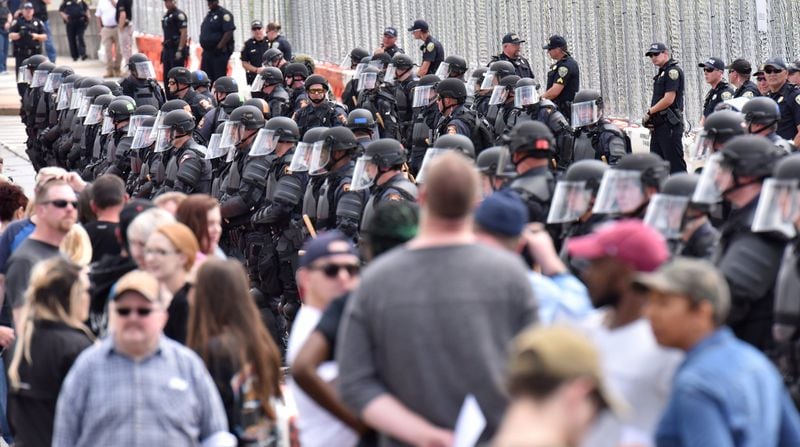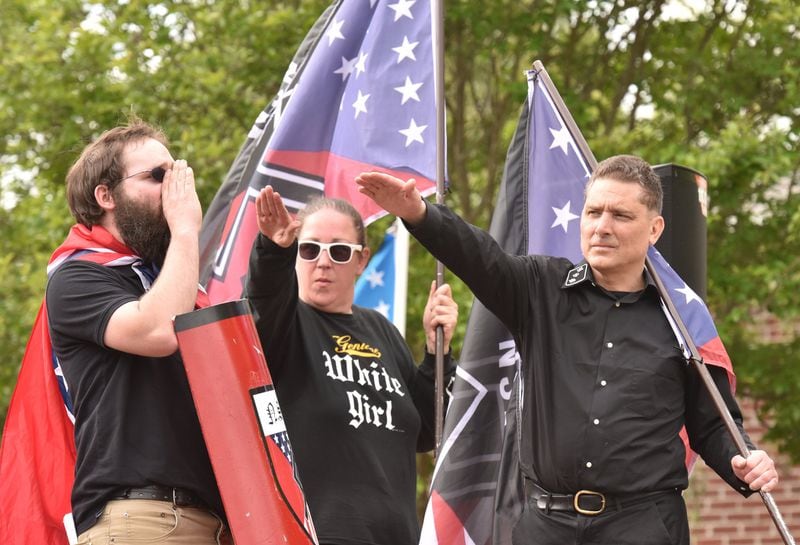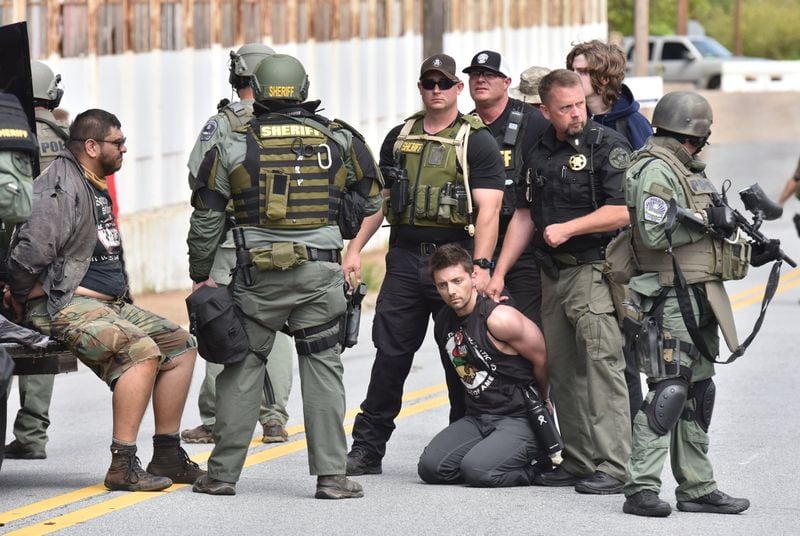Newnan City Manager Cleatus Phillips had a terrible vision when a neo-Nazi group requested a permit request in early March to hold a rally in his town: Charlottesville.
“This was the group in Charlottesville,” he said.
The National Socialist Movement, one of the largest organized extremist groups in the nation, was among a coalition of far-right groups that took part in last August's "Unite The Right" rally in Charlottesville, Va. That rally ended in bloody encounters between white supremacists and counter-demonstrators, including the death of counter-demonstrator Heather Heyer.
In the wake of the violence, Charlottesville officials were criticized for failing to keep the two sides apart and not intervening fast enough when the violence started. So when the National Socialists petitioned the city for the right to stage a rally there April 21, Newnan prepped to be the anti-Charlottesville.
Nearly 700 law enforcement officers, bristling with combat-style guns and gear, smothered the city for blocks, corralled the white supremacist group in a small park, and kept hundreds of counter-protesters behind barriers and chain link more than 100 yards away. While the strategy kept the two sides from fighting, it led to some accusing Newnan of overkill and police militarization.
With the one-year anniversary of Unite The Right approaching, The Atlanta Journal-Constitution reviewed hundreds of pages of emails and other documents from the weeks prior to the National Socialist rally to see how the lessons learned from Charlottesville shaped Newnan’s response. The documents illustrate the emerging law enforcement strategy to contain far-right rallies and the thousands of counter-demonstrators who show up to oppose them.
They also show how police wrestled with some of the common problems associated with these rallies. The far-right groups typically over-estimate their numbers. The National Socialist Movement’s application predicted up to 100 of their members would attend, but drew about a third that number.
Meanwhile anti-fascists, or “antifa,” groups are loosely organized with decentralized leadership and are wary of disclosing their plans or their numbers beforehand.
The Newnan rally was similar to a rally two years earlier at Stone Mountain where a small number of Ku Klux Klan members announced their plan to hold a "white power" rally, prompting a massive response from counter demonstrators who aimed to disrupt it.
“It was a real challenge,” said John Bankhead, spokesman for the Stone Mountain Memorial Authority.
Like in Newnan, Stone Mountain’s police force relied on manpower and intelligence from a host of other agencies to prepare for the rally. On the day of the demonstration, antifa-led protesters attempted to overwhelm the police, flooding into the park in an attempt to reach the white supremacist camp.
A coalition of law enforcement created a slow-moving cordon that kept counter protesters away from the white supremacists for hours.
“They were burning things, throwing rocks and fireworks,” Bankhead recalled. “They finally got to see the Klan, (it was) 20-some-odd members. I think that changed their attitude. They just sat and watched. But it was a struggle to begin with.”
Massive police presence planned
In planning for the Newnan rally, emails show the police response was to be over prepared.
“The people coming are professional ‘problem makers,’ and they are good at what they do,” a Newnan Police SWAT sergeant wrote to his team in an email a day before the rally. “We are professional ‘problem solvers,’ and we are better at what we do.”
The sergeant warned his colleagues say professional “in the face of pure evil.”
One of the first things city law enforcement did was to reach out to their counterparts in Charlottesville for advice, Phillips said. Records show they also asked for help from the law enforcement leaders in Shelbyville and Murfreesboro, Tenn., which both were targets for white supremacist rallies in the months after Charlottesville but avoided violent clashes.
The Southern Poverty Law Center, which tracks hate groups and has criticized antifa groups for fighting white supremacists, said Newnan employed many of the best practices developed since Charlottesville. Unlike Stone Mountain, where police had to deal with a wide-open park, Newnan police set up road blocks and checkpoints, forcing demonstrators to submit to searches for weapons before they could proceed.
Antifa and other groups have claimed police based their response on a paranoid screed posted on the Facebook account of a local militia group warning of up to 1,000 neo-Nazis and up to 12,000 counter-demonstrators. Records show Police Chief Buster Meadows was attempting track down the original author of the post the day prior to the rally, but earlier documents show that planning for the response was completed long before the post was created.
In fact, city officials planned for a massive police presence even before the size of the protest was known. In a March 16 email, Deputy Police Chief Mark Cooper announced every member of the department would be expected to work the rally.
By April 9, Meadows said in another email he would seek “up to 500 additional officers” from other agencies to join his city force.
“We have no idea how many protesters or counter protesters will be present,” he said.
Police did arrest 12 counter-demonstrators, most of whom were arrested on minor charges in an encounter blocks away from the rally site when police demanded they remove their masks. Photos of police in military-style gear pointing assault rifles at unarmed protesters ricocheted across social media.
Newnan Mayor Keith Brady said the photos tell just a portion of the story that day.
“The goal of the plan was nobody gets hurt and nothing gets damaged,” he said. “We accomplished those two goals.”
LaGrange Police Chief Louis Dekmar, who is president of the International Association of Police Chiefs, said the multi-agency approach to public demonstrations has a long history in Georgia. The 1988 Democratic National Convention, the G8 Summit on Sea Island in 2004 and any number of Klan marches over the years relied on a coalition of law enforcement, he said.
Dekmar said he sent a unit of his own officers to help out with the Newnan rally.
“That is historically what we have done in Georgia,” he said. “We have a sound history and a cooperative interdepartmental attitude that is enjoyed throughout the law enforcement community.”
Direct costs top $110,000
The response came with a hefty price tag. Accounting documents show Newnan spent $111,589 on the rally, only $50 of which was defrayed by the permit fee paid by the National Socialists. That figure doesn’t account for the costs borne by 41 other federal, state and local law enforcement agencies that sent people and equipment to assist the local department.
But it could have been worse. Phillips said the group originally asked to hold the protest on the town square, centered around a Confederate monument outside the historic Coweta County Courthouse. The square presented a large number of security concerns, including the possibility of damage to a large number of businesses.
Phillips said he suggested to the group that the rally be staged a few blocks south in Greenville Street Park, an area that could be easily cordoned off.
“We knew they had a right to the courthouse square,” he said. “For whatever reason, (the National Socialist Movement) was willing to change locations.”
Jeff Schoep, leader of the National Socialist Movement, said he thought the number of police assigned to the rally was “overkill,” but he had no complaints about how the city handled it after Charlottesville.
Some in the many and varied groups of counter-demonstrators who turned out to express their disgust in Schoep’s group said Newnan’s police response was one-sided. Daniel Hanley, an Atlanta resident and activist, said the heavy-handed police response unfairly targeted peaceful protesters.
“Violence is violence, regardless of who perpetrates it,” he said. “The aggressive, militarized police response was beyond anything I have seen.”
Hanley was one of the activists arrested at the rally. According to police records, he was charged with walking in the roadway, a misdemeanor for which he was handcuffed and carted away. He said he was jerked by police into a road that was closed to traffic. The case is listed as “under review” by the Coweta County District Attorney.
“To say police were keeping the peace and not escalating the situation is a dangerous misrepresentation,” he said.
Cliff Fisher, president of the Coweta County African American Alliance, brought 70 of his members to take part in the counter-demonstration. Unlike other groups, Fisher communicated with city leaders the plans of his group of local activists, some of whom he told police would carry firearms for protection.
Fisher said he didn’t have any problem with the large number of police assembled for the rally.
“I knew it was necessary because the entire time the chief of police kept reiterating, ‘We do not want to have a repeat of Charlottesville,’” he said. “The police wanted to make sure that they had enough manpower to diffuse violence as quickly as possible.”
The Newnan rally by the numbers
Marchers: 500-600
Police: 700
Police Agencies: 42
Arrests: 12
Cost: $111,589*
Note: Cost to Newnan; does not include other agencies.
Source: City of Newnan









